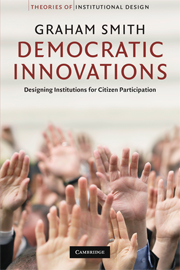Book contents
- Frontmatter
- Contents
- Acknowledgments
- Introduction
- 1 Studying democratic innovations: an analytical framework
- 2 Popular assemblies: from New England town meetings to participatory budgeting
- 3 Mini-publics: assemblies by random selection
- 4 Direct legislation: direct democracy through the ballot box
- 5 E-democracy: the promise of information and communication technology
- 6 Realising the goods of democratic institutions
- Conclusion
- References
- Index
2 - Popular assemblies: from New England town meetings to participatory budgeting
Published online by Cambridge University Press: 19 January 2010
- Frontmatter
- Contents
- Acknowledgments
- Introduction
- 1 Studying democratic innovations: an analytical framework
- 2 Popular assemblies: from New England town meetings to participatory budgeting
- 3 Mini-publics: assemblies by random selection
- 4 Direct legislation: direct democracy through the ballot box
- 5 E-democracy: the promise of information and communication technology
- 6 Realising the goods of democratic institutions
- Conclusion
- References
- Index
Summary
The classical Athenian assembly, where citizens (read Athenian males) gathered together to debate and decide law and policy, continues to transfix (Dunn 2005; Saxonhouse 1993). The idea of a popular assembly where citizens engage in face-to-face interactions and decision-making is arguably the touchstone for much writing on citizen participation: for example, the neighbourhood assembly open to all residents is a fundamental building block of Benjamin Barber's vision of strong democracy (Barber 1984: 267–73). For sceptics and critics, such participation is impossible and/or undesirable to institutionalise in large-scale, complex democracies. In most advanced industrial democracies, the nearest we come to such assemblies is the open public meeting that is often the central element of public authority consultation exercises. But, as we noted in the last chapter, such public meetings are a poor imitation of Athenian practice: self-selection leads to unequal participation; participants exercise minimal popular control; there is little time for citizens to develop considered judgements, and so on. Can innovations based on popular assemblies overcome these weaknesses and realise a compelling combination of goods of democratic institutions?
The New England town meeting, first established in the seventeenth century and arguably the nearest modern equivalent of the Greek assembly, receives surprisingly little systematic treatment within democratic theory. This institution was much admired by Alexis de Tocqueville when he visited the United States in the mid-nineteenth century: ‘Town meetings are to liberty what primary schools are to science; they bring it within the people's reach, they teach men [sic] how to use and enjoy it’ (quoted in Bryan 1999: 195).
- Type
- Chapter
- Information
- Democratic InnovationsDesigning Institutions for Citizen Participation, pp. 30 - 71Publisher: Cambridge University PressPrint publication year: 2009



